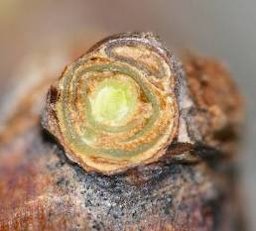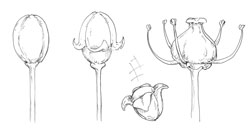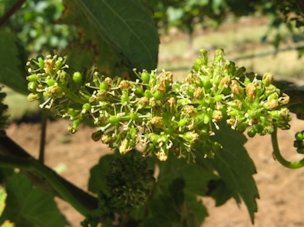
Fig. 1
A cross section of a dormant bud. The three buds within the compound bud can be seen.
BudsA bud contains growing points that develop in the leaf axil, the area
just above the point of connection between the petiole and shoot. The
single bud that develops in this area is described in botanical terms
as an axillary bud. It is important to understand that a bud develops
in every leaf axil on grapevines, including the inconspicuous basal
bracts (scale-like leaves). In viticulture terminology, we describe the
two buds associated with a leaf – the lateral bud and the dormant bud
(or latent bud). The lateral bud is the true axillary bud of the
foliage leaf, and the dormant bud forms in the bract axil of the
lateral bud. Because of their developmental association, the two buds
are situated side-by-side in the main leaf axil.
Although the
dormant bud (sometimes called an “eye”) looks like a simple structure,
it is actually a compound bud consisting of three growing points,
sometimes referred to as the primary, secondary, and tertiary buds
within one bud. The distinction between secondary and tertiary buds is
sometimes difficult to make when observing the bud visually and is
often of little importance, so it is common to refer to both of the
smaller buds as secondary buds. These three buds are packaged together
within a group of external protective bud scales within the compound
bud. As the bud develops, it follows the pattern of nomenclature as the
buds on the shoot: the primary growing point is the axillary bud of the
lateral bud; the secondary and tertiary growing points are the axillary
buds of the first two bracts of the primary growing point.
The
dormant bud is the focal point during dormant pruning, since it
contains cluster primordia (the fruit-producing potential for the next
season). It is called dormant to reflect the fact that it does not
normally grow out in the same season in which it develops.
The
dormant bud initiates the year prior to its growthGrapeExtOrg3.jpg as a shoot. During
that prior season, it undergoes considerable development. The three
growing points of the compound bud each produce a rudimentary shoot
that ultimately will contain primordia (organs in their earliest stages
of development) of the same basic components that comprise the current
season’s fully grown shoot: leaves, tendrils, and in some cases flower
clusters. The primary bud develops first; therefore it is the largest
and most fully developed by the time the bud goes dormant. If it is
produced under favorable environmental and growing conditions, it will
contain flower cluster primordia before the end of the growing season.
The flower cluster primordia thus represent the fruiting potential of
the bud in the following season. Reflecting the sequence of
development, the secondary and tertiary buds are progressively smaller
and less developed. They generally will be less fruitful (have fewer
and smaller clusters) than the primary bud. Bud fruitfulness (potential
to produce fruit) is a function of the variety, environmental
conditions, and vineyard production practices. Dormant buds that
develop under unfavorable conditions (shade of a dense canopy, poor
nutrition, etc.) produce fewer flower cluster primordia for the
following season.
In most cases, only the primary bud grows, producing the primary
shoot in the following season. The secondary bud can be thought of as a
“backup system” for the vine; normally, it grows only when the primary
bud or young shoot has been damaged, oftentimes from freeze or frost in
spring. However, under some conditions such as severe pruning,
destruction of part of the vine, or boron deficiency, it is possible
for two or all three of the buds to produce shoots in spring (Winkler
et al., 1974). Tertiary buds provide additional backup if both the
primary and secondary buds are damaged, but they usually have no flower
clusters and thus no fruit. If only the primary shoot grows, the
secondary and tertiary buds remain alive, but dormant at the base of
the shoot.
The lateral bud will grow in the current season, but
growth may either cease soon after formation of the basal bract or it
can continue, producing a lateral shoot (summer lateral) of variable
length. Regardless of the extent of lateral bud development, a compound
bud develops in the basal bract, forming the dormant bud. Long lateral
shoots sometimes produce flower clusters and fruit, which is known as
"second crop." However, because these develop later in the season than
fruit on the primary shoot, “second crop” fruit does not fully mature
in many areas of the country. If a lateral bud does not grow in the
current season, it will die.
Flowers and FruitA
fruitful shoot will usually produce one to three flower clusters
(inflorescences) depending on variety. Flower clusters develop opposite
the leaves typically at the third to sixth nodes from the base of the
shoot, depending on the variety. If three flower clusters develop, two
develop on adjacent nodes, the next node has none, and the following
node has the third flower cluster. The number of flower clusters on a
shoot is dependent upon the grape variety and the conditions of the
previous season under which the dormant bud (that produced the primary
shoot) developed. A cluster may contain several to many hundreds of
individual flowers, depending on variety.


Fig. 2
Grape
buds and flowers.
A compound bud with primary, secondary, and tertiary
buds (T),
and flowers from formation to cap fall to pre-fertilization.
The
grape flower does not have conspicuous petals, instead, the petals are
fused into a green structure termed the calyptra, but commonly referred
to as the cap. The cap encloses the reproductive organs and other
tissues within the flower. A flower consists of a single pistil (female
organ) and five stamens, each tipped with an anther (male organ). The
pistil is roughly conical in shape, with the base disproportionately
larger than the top, and the tip (called the stigma) slightly flared.
The broad base of the pistil is the ovary, and it consists of two
internal compartments, each having two ovules containing an embryo sac
with a single egg. The anthers produce many yellow pollen grains, which
contain the sperm. Wild grapevines, rootstocks (and a few cultivated
varieties such as St. Pepin) have either pistillate (female) or
staminate male flowers -- that is, the entire vine is either male or
female. Vines with female, pistillate flowers need nearby vines with
staminate or perfect flowers to produce fruit. The majority of
commercial grapevine varieties have perfect flowers, that is, both male
and female components.

Fig. 3
An individual grape flower is shown with floral parts labeled
Stages of BloomWhen
the individual flowers on a grape inflorescence open, it looks
different than the bloom of most flowers. The cap separates from the
base of the flower, becomes dislodged and usually falls off, exposing
the pistil and anthers. The anthers may release their pollen either
before or after cap fall. Pollen grains randomly land upon the stigma
of the pistil, allowing pollination. Multiple pollen grains can
germinate, each growing a pollen tube down the pistil to the ovary and
entering an ovule, where a sperm unites with an egg to form an embryo.
The successful union is termed fertilization, and the subsequent growth
of berries is called "fruit set." The berry develops from the tissues
of the pistil, primarily the ovary. The ovule together with its
enclosed embryo develops into the seed.

Fig. 4
A grape inflorescence with nearly 100% cap fall
Because
there are four ovules per flower, there is a maximum potential of four
seeds per berry. Unfavorable environmental conditions during bloom such
as cool, rainy weather can reduce fruit set (number of berries) and
seeds per berry, thereby affecting berry size. Berry size is related to
the number of seeds within the berry, and very few seeds leads to
smaller berries. However, berry size can also be influenced by
environmental conditions, management practices, and water management.
Some immature berries may be retained by a cluster without completing
their normal growth and development, a phenomenon known as “ coulure”
or “hens and chicks” (Mullins et al., 1992).
Reviewed by Tim Martinson, Cornell University and Patty Skinkis, Oregon State University
References:Mullins, M. G., A. Bouquet, and L. E. Williams. 1992. Biology of the Grapevine. Cambridge University Press.




